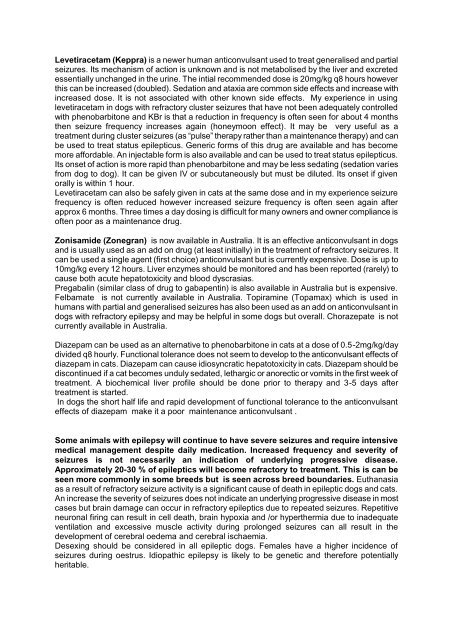Seizure disorders in dogs - Australian Veterinary Association
Seizure disorders in dogs - Australian Veterinary Association
Seizure disorders in dogs - Australian Veterinary Association
You also want an ePaper? Increase the reach of your titles
YUMPU automatically turns print PDFs into web optimized ePapers that Google loves.
Levetiracetam (Keppra) is a newer human anticonvulsant used to treat generalised and partialseizures. Its mechanism of action is unknown and is not metabolised by the liver and excretedessentially unchanged <strong>in</strong> the ur<strong>in</strong>e. The <strong>in</strong>tial recommended dose is 20mg/kg q8 hours howeverthis can be <strong>in</strong>creased (doubled). Sedation and ataxia are common side effects and <strong>in</strong>crease with<strong>in</strong>creased dose. It is not associated with other known side effects. My experience <strong>in</strong> us<strong>in</strong>glevetiracetam <strong>in</strong> <strong>dogs</strong> with refractory cluster seizures that have not been adequately controlledwith phenobarbitone and KBr is that a reduction <strong>in</strong> frequency is often seen for about 4 monthsthen seizure frequency <strong>in</strong>creases aga<strong>in</strong> (honeymoon effect). It may be very useful as atreatment dur<strong>in</strong>g cluster seizures (as “pulse” therapy rather than a ma<strong>in</strong>tenance therapy) and canbe used to treat status epilepticus. Generic forms of this drug are available and has becomemore affordable. An <strong>in</strong>jectable form is also available and can be used to treat status epilepticus.Its onset of action is more rapid than phenobarbitone and may be less sedat<strong>in</strong>g (sedation variesfrom dog to dog). It can be given IV or subcutaneously but must be diluted. Its onset if givenorally is with<strong>in</strong> 1 hour.Levetiracetam can also be safely given <strong>in</strong> cats at the same dose and <strong>in</strong> my experience seizurefrequency is often reduced however <strong>in</strong>creased seizure frequency is often seen aga<strong>in</strong> afterapprox 6 months. Three times a day dos<strong>in</strong>g is difficult for many owners and owner compliance isoften poor as a ma<strong>in</strong>tenance drug.Zonisamide (Zonegran) is now available <strong>in</strong> Australia. It is an effective anticonvulsant <strong>in</strong> <strong>dogs</strong>and is usually used as an add on drug (at least <strong>in</strong>itially) <strong>in</strong> the treatment of refractory seizures. Itcan be used a s<strong>in</strong>gle agent (first choice) anticonvulsant but is currently expensive. Dose is up to10mg/kg every 12 hours. Liver enzymes should be monitored and has been reported (rarely) tocause both acute hepatotoxicity and blood dyscrasias.Pregabal<strong>in</strong> (similar class of drug to gabapent<strong>in</strong>) is also available <strong>in</strong> Australia but is expensive.Felbamate is not currently available <strong>in</strong> Australia. Topiram<strong>in</strong>e (Topamax) which is used <strong>in</strong>humans with partial and generalised seizures has also been used as an add on anticonvulsant <strong>in</strong><strong>dogs</strong> with refractory epilepsy and may be helpful <strong>in</strong> some <strong>dogs</strong> but overall. Chorazepate is notcurrently available <strong>in</strong> Australia.Diazepam can be used as an alternative to phenobarbitone <strong>in</strong> cats at a dose of 0.5-2mg/kg/daydivided q8 hourly. Functional tolerance does not seem to develop to the anticonvulsant effects ofdiazepam <strong>in</strong> cats. Diazepam can cause idiosyncratic hepatotoxicity <strong>in</strong> cats. Diazepam should bediscont<strong>in</strong>ued if a cat becomes unduly sedated, lethargic or anorectic or vomits <strong>in</strong> the first week oftreatment. A biochemical liver profile should be done prior to therapy and 3-5 days aftertreatment is started.In <strong>dogs</strong> the short half life and rapid development of functional tolerance to the anticonvulsanteffects of diazepam make it a poor ma<strong>in</strong>tenance anticonvulsant .Some animals with epilepsy will cont<strong>in</strong>ue to have severe seizures and require <strong>in</strong>tensivemedical management despite daily medication. Increased frequency and severity ofseizures is not necessarily an <strong>in</strong>dication of underly<strong>in</strong>g progressive disease.Approximately 20-30 % of epileptics will become refractory to treatment. This is can beseen more commonly <strong>in</strong> some breeds but is seen across breed boundaries. Euthanasiaas a result of refractory seizure activity is a significant cause of death <strong>in</strong> epileptic <strong>dogs</strong> and cats.An <strong>in</strong>crease the severity of seizures does not <strong>in</strong>dicate an underly<strong>in</strong>g progressive disease <strong>in</strong> mostcases but bra<strong>in</strong> damage can occur <strong>in</strong> refractory epileptics due to repeated seizures. Repetitiveneuronal fir<strong>in</strong>g can result <strong>in</strong> cell death, bra<strong>in</strong> hypoxia and /or hyperthermia due to <strong>in</strong>adequateventilation and excessive muscle activity dur<strong>in</strong>g prolonged seizures can all result <strong>in</strong> thedevelopment of cerebral oedema and cerebral ischaemia.Desex<strong>in</strong>g should be considered <strong>in</strong> all epileptic <strong>dogs</strong>. Females have a higher <strong>in</strong>cidence ofseizures dur<strong>in</strong>g oestrus. Idiopathic epilepsy is likely to be genetic and therefore potentiallyheritable.

















